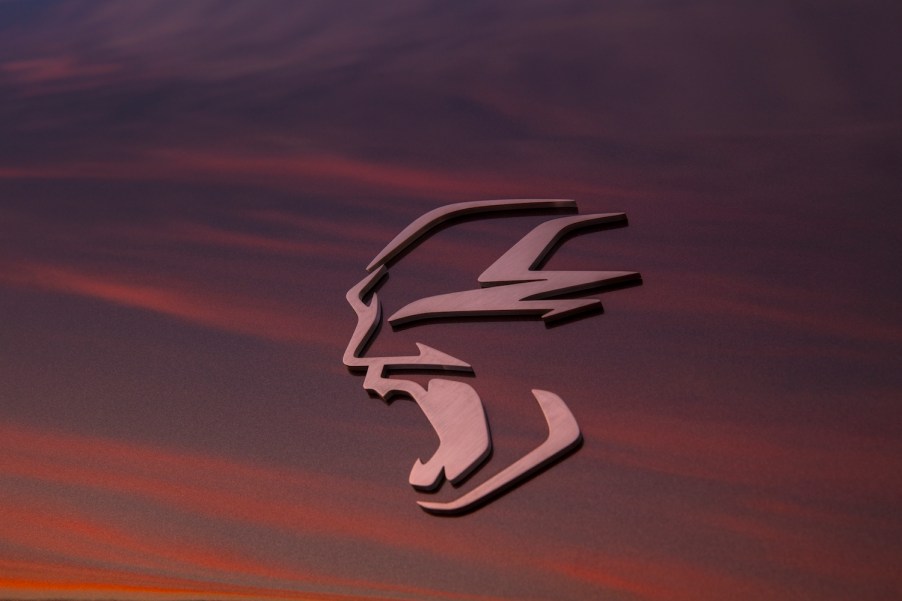
Dodge Just Killed the Hellcat–and the Banshee Is Here To Replace It
After 18 years as one of the most powerful V8s in history, Dodge is finally killing its supercharged Hellcat engine option. The 2023 model year will feature six “Last Call” special edition Hellcat models. Waiting in the wings is the Banshee, an all-electric, 800-volt SRT “eMuscle” powertrain. Dodge aims to make its Banshee the Hellcat of the future.
Is Dodge still building the Hellcat?
Dodge is building Hellcat V8 engines–both in “Last Call” special edition cars and as crate motors–for the 2023 model year. The automaker plans to kill the Hellcat badge by the end of 2023.

Back in 2021 the brand’s CEO, Tim Kuniskis said of the Hellcat, “I will have this car, this platform, this powertrain as we know it through the end of ’23…There’s two more years to buy a Hellcat, then it’s history.”
Will Dodge continue building Hellcat crate engines for hotrodders seeking a supercharged V8? There is nothing to prevent Dodge’s SRT division from continuing to sell the “Hellcrate” motor and performance parts, and nothing to indicate it will cease doing so.
Kuniskis said that the current configuration of the Charger sedan, Challenger coupe, and Durango SUV will not last past the 2023 model year. That said, the nameplates won’t necessarily end. Stellantis has already unveiled an all-electric Charger, the new Charger Daytona.
In addition, the next generation of Dodge vehicles will likely offer internal combustion hybrid drivetrains. But the top performance trim of Dodge muscle will not be the supercharged Hellcat, it will not even use internal combustion. It will be the Banshee.
Is the Banshee a Dodge car?
The Banshee will be a badge designating Dodge’s most powerful eMuscle vehicles. Like Hellcat before it, multiple vehicles across Dodge’s lineup may wear the Banshee badge. We don’t know much about this powertrain, but it promises an 800+ volt system, and will likely make much more than the Hellcat’s 707 horsepower.

Take, for example, the Dodge Charger Daytona. The automaker will offer the regular (non-SRT) Charger Daytona with a 400-volt powertrain. Buyers will be able to then opt for either a 300 kW or 440 kW trim level. These will correspond to 456 horsepower and 590 horsepower respectively. Owners can then purchase Dodge Direct Connection aftermarket tunes and unlock up to 670 horsepower.
The flagship version of the car will be the Charger Daytona SRT Banshee. We do not know much about this car, but we know its powertrain will offer twice as many volts: 800 in total. This voltage corresponds to how much power the vehicle can funnel into–or out of–its battery. So if a 400-volt powertrain can make 670 horsepower, you can begin to imagine what the top end of an 800-volt powertrain will be. Direct Connection will sell two levels of aftermarket kits to increase this power even further.
Will Dodge offer upgrades for its eMuscle cars?
Dodge’s Direct Connection aftermarket parts branch is gearing up to offer upgrades to its eMuscle cars. These will range from carbon fiber rims to performance keys which unlock more power.

Charger Daytona buyers can then opt for the Dodge Direct Connection Stage 1 and Stage 2 tunes. These are simply a “crystal” key that you purchase and plug into your dashboard. So, if you order an upper trim 440 kW Charger Daytona and buy the Stage 2 upgrade, you can unlock a 500 kW (670 horsepower) powertrain. Here’s how the regular, non-SRT, 400-volt Charger Daytona power levels break down:
| Trim Level | Kilowatt Rating | Horsepower Equivalent |
| Charger Daytona 340 (base) | 340 kW | 455 hp |
| Charger Daytona 340 (eStage 1) | 370 kW | 495 hp |
| Charger Daytona 340 (eStage 2) | 400 kW | 535 hp |
| Charger Daytona 440 (base) | 440 kW | 590 hp |
| Charger Daytona 440 (eStage 1) | 479 kW | 630 hp |
| Charger Daytona 440 (eStage 2) | 500 kW | 670 hp |
Next, check out the “Goes Like Hell” trim of Dodge’s Hornet SUV or watch NBC’s investigation into the Charger Daytona EV in the video below:



